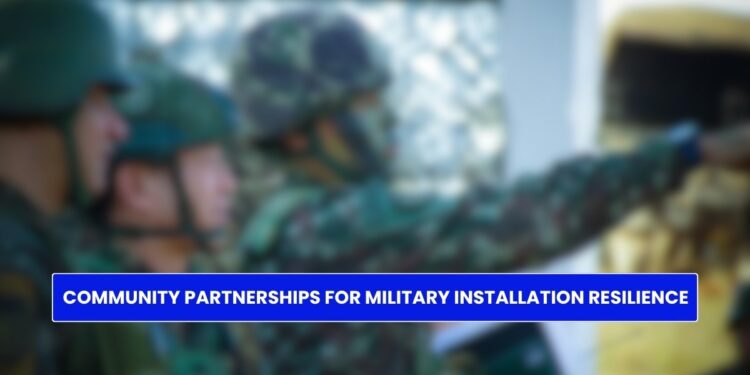Community Partnership is playing an important role in funding and addressing the challenges for the US military installation resilience for national security, protection against climate change, and other vulnerabilities. Let’s see how the community partnerships are working for the US military.
The military installation’s resilience is important to enhance the capability of the military installation and improve access to outdoor recreation for defense communities. The local communities have come forward to help with the local military installations for long-term installations.
The Department of Defense has taken various steps to foster community partnerships through funding, infrastructure, and others. The DoD partnered with other agencies to initiate the program, like REPI, DCIP, and many others, to support the community partnerships.
How does the Community partnership work for military installation resilience?
The Community Partnership involves the collaboration between local communities and nearby military installations to solve the shared threats, reduce climate change effects, mitigate the risk, and allocate resources. If you were wondering how it works for the military installation resilience, you can check it below:
- The community partnerships involve surrounding communities and DoD, where the first step is to do a risk assessment and planning. The local government and military installations identify the threats, such as climate change, drought, etc.
- The community groups, local government, federal agencies, and military leadership will come together and work on strategies to resolve or mitigate the risks involved.
- The community partnership gets support from the federal funding or other programs that strengthen each partner and the overall installations.
- The collaboration will benefit the community, defence communities, public, and military operations, overall, to the whole nation.
- The communities strive to have a resilient military installation for a better future and approach the shared challenges to enhance the whole system.
What are the federal programs and initiatives to support community partnerships?
The federal agencies or the government have taken the following initiatives to strengthen community partnerships to enhance military installation resilience:
- DoD and Department of the Interior collaboration:
- The DoD and the Department of the Interior have come together to preserve and conserve the land around military installations.
- Through the Readiness and Recreation Initiative, the DOI’s National Park Service will receive the funding of $40 million from the Land and Water Conservation Fund to protect water resources, protect natural assets, and preserve the cultural heritage sites.
- The partnership between the two support projects recreates opportunities, protects natural areas, and improves military installation resilience.
- The program works for the projects on private, state, or local lands within the REPI area.
- REPI program:
- The DoD started the REPI (Readiness and Environmental Protection Integration Program to preserve military missions through partnership between federal agencies, military services, state and local governments.
- The program aims to mitigate the conflicts arising near military installations and make them more resilient to the environment and other issues, too.
- Till FY 2024, the DoD offers $1.5 billion, where $1.4 billion has come from partner contributions to protect 130 million acres of land, preserving infrastructure, assets, and capabilities.
- DCIP:
- DCIP (Defence Community Infrastructure Program) is a competitive program for communities, states, or territories for infrastructure enhancements to support the military training, educational, and other defence communities’ requirements.
- Recently, the Department of War provided $90 million in funds from the Office of Local Defence Community Cooperation to improve the quality of life and invest in critical infrastructure.
- Many departments and councils of various US states have received funds under this program, such as $4.8 million to the Port Authority of Guam, $10 million to the Oklahoma Transportation Department.
- Military Installation Sustainability:
- The MIS supports the local governments and defence communities in implementation and planning for climate resilience projects, infrastructure sustainability, and land use around military installations.
- The MIS is integrated with DCIP and REIP to support the community partnerships.
What are the biggest community partnerships in the US for military installations?
IGSA helps the US Army to enter into a partnership between private and public with state or local government or authorities to enhance military installations. According to reports, the biggest partnership on the IGSA portfolio is with Fort Moore.
The partnerships involve local communities to improve, maintain, and reduce the cost of enhancing the existing installation. Fort Morre has two regional IGSA/s with the University of Georgia and Auburn University to improve the environment, engineering, and safeguard the national assets.
What are the challenges related to the Community partnership for military installations?
The community partnerships are coming in handy for the military installation resilience, which is the demand of the time; however, there are some challenges involved, which we need to address, such as:
- Awareness: Sometimes, the community members or groups are not aware of the federal programs and funding to build a healthy community.
- Funding: The local communities and military installations can sometimes lack funds, which often disrupts the whole process and makes it difficult to find effective and beneficial solutions.
- Cultural and communication: With communities involved, sometimes the cultural norms or values can disrupt the military installation, which may hinder the partnerships.
- Climate Change: Climate change activities like drought, floods, and others have increased in the US, hence it’s high time we focus on climate resilience and an adaptable approach for long-term military installations.
The US federal authorities, military, and local community are coming together for resilient military installations to improve the quality of life, enhance national security, and safeguard nature as well.









